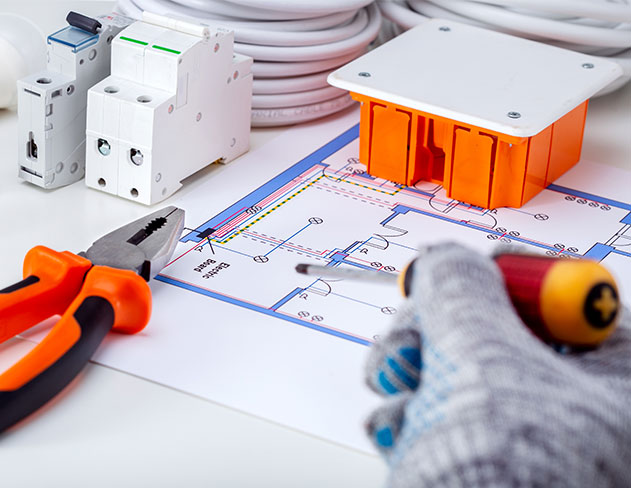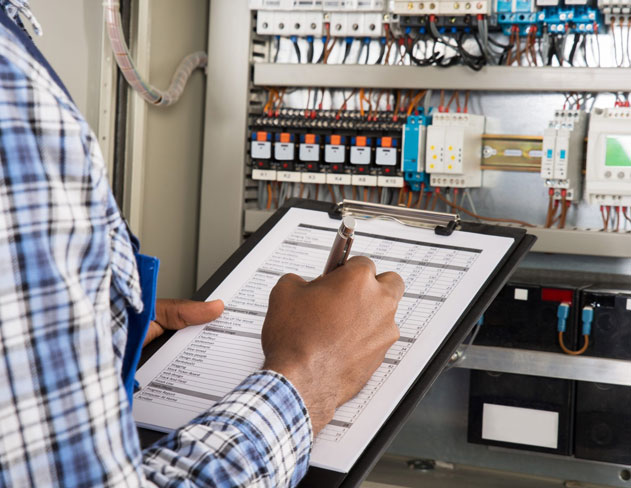If you’re booking an EICR, there’s every chance you’ll be interested in the process our qualified and competent electricians will undertake in your premises.
So here we break it down for you, giving you the step-by-step process on what you can expect.
Our EICR Procedure
Initial Inspection
The EICR process kicks off with a meticulous visual inspection. As a team of experienced electrical engineers, we delve into the heart of your property’s electrical system. We’re on the lookout for any visible signs of wear and tear, damage, or ageing. This isn’t a cursory glance; we scrutinise every component, from the condition of the wiring and light fittings to the plug sockets and the consumer unit or fuse box.
We understand that the devil is in the details. A loose wire here, a damaged plug socket there, or an outdated fuse box can all pose significant safety risks. Identifying these issues early on can help prevent potential electrical accidents and ensure your property complies with the latest safety standards.
Testing Electrical Circuits
Once the visual inspection is complete, we roll up our sleeves and get down to the nitty-gritty – testing the electrical circuits. This is a two-part process. First, we conduct dead testing, where we test the circuits without power. This allows us to check for continuity, insulation resistance, and polarity. It’s like a health check-up for your electrical system, ensuring everything is functioning as it should.
Next, we perform live testing. This involves checking for earth fault loop impedance, prospective short circuit current, and RCD testing. Live testing is crucial as it helps us identify any hidden faults that might not be apparent during the visual inspection. It’s like having an X-ray perspective on your electrical system, this allows us to spot potential issues before they escalate into serious problems.
Identifying Faults and Non-Compliance Issues
During the EICR, we’re like detectives, identifying any faults or non-compliance issues. We categorise these using EICR codes, which provide a clear and concise way of communicating the severity of any issues found. If we uncover any faults, we don’t just leave you in the lurch. We recommend remedial actions to bring your system up to a safe standard.
But we don’t stop there. We also provide a detailed report of our findings. This report is your roadmap to electrical safety, outlining the current state of your electrical system, any issues found, and the recommended steps to fix them. You can learn more about what to expect from this report in our guide on EICR pre-inspection checklists for landlords.
In essence, the EICR procedure is a comprehensive health check for your property’s electrical system. It’s a crucial step in ensuring the safety of your property and everyone who lives or works there. At Hexo Electrical Testing, we’re committed to providing a thorough, professional, and transparent service, helping you easily navigate the complexities of electrical safety.
What Is EICR?
An Electrical Installation Condition Report (EICR) is a thorough evaluation of a property’s electrical installations. Its purpose is to pinpoint any safety shortcomings, defects, or non-compliance with the current safety standard. The EICR encompasses the entire fixed electrical system, including consumer units (also known as fuse boxes), wiring, light fittings, plug sockets, and switches.
Why Is EICR Important?
EICRs are vital for ensuring the safety of a property’s electrical installations. They aid in preventing electrical accidents by identifying potential issues and suggesting necessary remedial actions. A satisfactory EICR is a legal requirement for landlords and commercial property owners. For homeowners, it’s a strong recommendation, particularly if you’re contemplating selling your home. You can delve deeper into this topic in our guide on whether you need an EICR to sell your home.
Legal Requirements and Standards for EICR
In the UK, landlords are legally obligated to have an EICR conducted every five years or at the change of tenancy. For commercial properties, the frequency of EICRs depends on the type of property and its use. For instance, industrial premises require an EICR every three years, while shops and offices require one every five years. The EICR must be carried out by a competent person, such as a qualified electrician or electrical engineer. Check out our detailed guide for more information on who can carry out an EICR.
Understanding EICR Codes
EICR Code Breakdown
EICR codes are used to classify the severity of any faults or non-compliance issues found during the EICR. These codes are:
- C1: Danger present – Immediate remedial action required
- C2: Potentially dangerous – Urgent remedial action required
- C3: Improvement recommended
- FI: Further investigation required
How EICR Codes Influence the Report
The EICR codes greatly influence the final report. If any C1 or C2 codes are found, the overall EICR will be deemed ‘unsatisfactory’, and immediate remedial action will be required. C3 codes, while not as severe, still indicate areas where the electrical installation could be improved.
Actions Required for Each Code
Each EICR code requires a different course of action. C1 and C2 codes require immediate or urgent remedial action, respectively. This could involve repairing or replacing faulty wiring or equipment. C3 codes, while not urgent, should still be addressed to improve the overall safety and efficiency of the electrical installation.
Post-EICR Procedure
Interpreting the EICR Report
After the EICR, you’ll receive a detailed report outlining the condition of your electrical installation. This report will include any faults or non-compliance issues found, along with their corresponding EICR codes. It will also include recommendations for remedial actions. If you’re unsure about any aspect of your report, don’t hesitate to ask your electrical engineer for clarification.
Implementing Recommendations
It’s crucial to implement the recommendations made in the EICR report. This could involve arranging for repairs or replacements to be carried out by a qualified electrician. At Hexo Electrical Testing, we offer a full remedial works service to bring your system up to a safe standard.
Scheduling Future EICR Checks
Regular EICR checks are essential for maintaining electrical safety. For landlords, this is typically every five years or at each change of tenancy. On the other hand, homeowners should have an EICR every ten years or when selling your home. When it comes to commercial properties, the frequency varies depending on the type of property and its use. You can learn more about this in our guide on how long an EICR lasts.
Common Questions About EICR
Who Can Perform an EICR?
An EICR must be carried out by a competent person, such as a qualified electrician or electrical engineer. They should have recognised industry-standard training and specialise in electrical testing and compliance. For more information, check out our guide on who can carry out an EICR.
How Long Does an EICR Take?
The length of an EICR depends on several factors, including the size and complexity of the property’s electrical installation. However, as a general rule, an EICR for a standard three-bedroom house typically takes around two to three hours, depending on what we find.
EICR Costs
The cost can vary, largely hinging on the size and complexity of your property’s electrical installation. But here’s the good news – at Hexo Electrical Testing, we’re all about delivering top-notch EICR services without making your wallet weep. For a closer look at our pricing, why not swing by our Domestic EICR Prices page or Commercial EICR Prices page?
Understanding the EICR Procedure – Time to Take the Next Step
Now that you’re clued up on the EICR procedure, it’s time to leap into action. Whether you’re a homeowner, a landlord, or a commercial property owner, scheduling an EICR is a straightforward and quick process.
And here’s the best part – you’re not in this alone. We, at Hexo Electrical Testing, are ready and raring to go. Our team of qualified electricians and electrical engineers are chomping at the bit to provide you with a comprehensive and professional EICR service. So, what are you waiting for? Contact us today to schedule your EICR.

